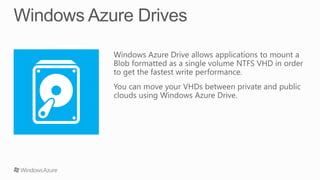Windows Azure Storage
- 1. 90 Day Free Trial: http://aka.ms/vs4rdw
- 18. About the Storage Services API MSDN Windows Azure Guidance – The “Get”, “Delete” pattern for reading messages from queues MSDN Storage Blog Windows Azure Storage Client for Java Overview Windows Azure Storage Client for Java Tables Deep Dive Windows Azure Storage Client for Java Blob Features
- 19. 90 Day Free Trial: http://aka.ms/vs4rdw
Editor's Notes
- #8: 狠狠撸 ObjectiveUnderstand different blob typesSpeaker NotesBlock blobs are comprised of blocks, each of which is identified by a block ID. You create or modify a block blob by uploading a set of blocks and committing them by their block IDs. If you are uploading a block blob that is no more than 64 MB in size, you can also upload it in its entirety with a single Put Blob operation.When you upload a block to Windows Azure using the Put Block operation, it is associated with the specified block blob, but it does not become part of the blob until you call the Put Block List operation and include the block's ID. The block remains in an uncommitted state until it is specifically committed. Writing to a block blob is thus always a two-step process.Each block can be a maximum of 4 MB in size. The maximum size for a block blob in version 2009-09-19 is 200 GB, or up to 50,000 blocks.Page blobs are a collection of pages. A page is a range of data that is identified by its offset from the start of the blob. To create a page blob, you initialize the page blob by calling Put Blob and specifying its maximum size. To add content to or update a page blob, you call the Put Page operation to modify a page or range of pages by specifying an offset and range. All pages must align 512-byte page boundaries.Unlike writes to block blobs, writes to page blobs happen in-place and are immediately committed to the blob.The maximum size for a page blob is 1 TB. A page written to a page blob may be up to 1 TB in size but will typically be much smallerNoteshttp://msdn.microsoft.com/en-us/library/dd135734.aspx
- #9: 狠狠撸 ObjectivesUnderstand the hierarchy of Blob storageSpeaker NotesThe Blob service provides storage for entities, such as binary files and text files. The REST API for the Blob service exposes two resources: Containers Blobs. A container is a set of blobs; every blob must belong to a container. The Blob service defines two types of blobs:Block blobs, which are optimized for streaming. Page blobs, which are optimized for random read/write operations and which provide the ability to write to a range of bytes in a blob. Blobs can be read by calling the Get Blob operation. A client may read the entire blob, or an arbitrary range of bytes. Block blobs less than or equal to 64 MB in size can be uploaded by calling the Put Blob operation. Block blobs larger than 64 MB must be uploaded as a set of blocks, each of which must be less than or equal to 4 MB in size. Page blobs are created and initialized with a maximum size with a call to Put Blob. To write content to a page blob, you call the Put Page operation. The maximum size currently supported for a page blob is 1 TB.Resourceshttp://msdn.microsoft.com/en-us/library/dd573356.aspxUsing the REST API for the Blob service, developers can create a hierarchical namespace similar to a file system. Blob names may encode a hierarchy by using a configurable path separator. For example, the blob names MyGroup/MyBlob1 and MyGroup/MyBlob2 imply a virtual level of organization for blobs. The enumeration operation for blobs supports traversing the virtual hierarchy in a manner similar to that of a file system, so that you can return a set of blobs that are organized beneath a group. For example, you can enumerate all blobs organized under MyGroup/.
- #11: 狠狠撸 ObjectivesUnderstand TablesSpeaker NotesThe Table service provides structured storage in the form of tables. The Table service supports a REST API that is compliant with the ADO.NET Data Services REST API. Developers may also use the .NET, java, PHP and Node.JS Client Libraries to access the Table service.Resourceshttp://msdn.microsoft.com/en-us/library/dd573356.aspx
- #12: 狠狠撸 ObjectivesUnderstand the Value of QueuesSpeaker NotesQueues allow the apparent perf of app to be improvedWork can be buffered in queue and performed laterAllows simple async comms between rolesNoteshttp://blogs.msdn.com/b/eugeniop/archive/2010/05/11/windows-azure-guidance-the-get-delete-pattern-for-reading-messages-from-queues.aspx
- #13: 狠狠撸 ObjectivesUnderstand QueuesSpeaker NotesThe Queue service provides reliable, persistent messaging within and between services. The REST API for the Queue service exposes two resources: queues and messages.Noteshttp://msdn.microsoft.com/en-us/library/dd573356.aspx
- #15: 狠狠撸 ObjectivesUnderstand Drives Mounting and CachingSpeaker NotesA Windows Azure drive acts as a local drive mounted on the file system and is accessible to code running in a role. The data written to a Windows Azure drive is stored in a page blob defined within the Windows Azure Blob service, and cached on the local file system.Because data written to the drive is stored in a page blob, the data is Durable.



















